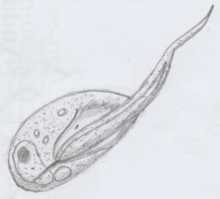Apusomonadida
The Apusomonadida are a group of protozoan zooflagellates that glide on surfaces, and mostly consume prokaryotes. They are of particular evolutionary interest because they appear to be the sister group to the Opisthokonts, the clade as that includes both animals and fungi. Together with the Breviatea, these form the Obazoa clade.[3][4][5]
| Apusomonadida | |
|---|---|
 | |
| Apusomonas sp. | |
| Scientific classification | |
| Class: | Apusomonadea |
| Order: | Apusomonadida Karpov & Mylnikov, 1989[1] |
| Family: | Apusomonadidae Karpov & Mylnikov, 1989[2] |
| Genera | |
| |
The taxon includes the genera Apusomonas, Amastigomonas, Manchomonas, Thecamonas, Podomonas, Multimonas and Chelonemonas. There is an effort to clarify the relationships between these genera.[6]
Taxonomy
- Class Apusomonadea Tedersoo 2017[7]
- Order Apusomonadida Karpov & Mylnikov 1989 [Thecomonadales Lee 1989]
- Family Apusomonadidae Karpov & Mylnikov 1989
- Genus Amastigomonas de Saedeleer 1931
- Species A. caudata Mylnikov 1989 [Amastigomonas borokensis Hamar 1979]
- Species A. debruynei de Saedeleer 1931
- Species A. marisrubri Mylnikov & Mylnikov 2012
- Genus Multimonas Cavalier-Smith 2010
- Species M. koreensis Heiss et al. 2015
- Species M. marina (Mylnikov 1989) Cavalier-Smith 2010 [Cercomonas marina Mylnikov 1989; Amastigomonas marina (Mylnikov 1989) Mylnikov 1999]
- Species M. media Cavalier-Smith 2010
- Genus Podomonas Cavalier-Smith 2010
- Species P. capensis Cavalier-Smith 2010
- Species P. gigantea (Mylnikov 1999) [Amastigomonas gigantea Mylnikov 1999]
- Species P. griebenis (Mylnikov 1999) [Amastigomonas griebenis Mylnikov 1999]
- Species P. klosteris (Arndt & Mylnikov 1999) Cavalier-Smith 2010 [Amastigomonas klosteris Arndt & Mylnikov 1999]
- Species P. magna Cavalier-Smith 2010
- Subfamily Apusomonadinae Karpov & Mylnikov 1989
- Genus Chelonemonas Heiss et al. 2015
- Species C. geobuk Heiss et al. 2015
- Species C. masanensis Heiss et al. 2015
- Genus Manchomonas Cavalier-Smith 2010
- Species Manchomonas bermudensis (Molina & Nerad 1991) Cavalier-Smith 2010 [Amastigomonas bermudensis Molina & Nerad 1991]
- Genus Apusomonas Alexeieff 1924 [Rostromonas Karpoff & Zhukov 1980]
- Species A. australiensis Ekelund & Patterson 1997
- Species A. proboscidea Alexeieff 1924 [Rostromonas applanata Karpoff & Zhukov 1980]
- Genus Thecamonas Larsen & Patterson 1990
- Species T. filosa Larsen & Patterson 1990 [Amastigomonas filosa (Larsen & Patterson 1990) Molina & Nerad 1991]
- Species T. muscula (Mylnikov 1999) Cavalier-Smith 2010 [Amastigomonas muscula Mylnikov 1999]
- Species T. mutabilis (Griessmann 1913) Larsen & Patterson 1990 [Rhynchomonas mutabilis Griessmann 1913; Amastigomonas mutabilis (Griessmann 1913) Patterson & Zölffel 1993]
- Species T. oxoniensis Cavalier-Smith 2010
- Species T. trahens Larsen & Patterson 1990 [Amastigomonas trahens (Larsen & Patterson 1990) Molina & Nerad 1991]
- Genus Chelonemonas Heiss et al. 2015
- Genus Amastigomonas de Saedeleer 1931
- Family Apusomonadidae Karpov & Mylnikov 1989
- Order Apusomonadida Karpov & Mylnikov 1989 [Thecomonadales Lee 1989]
gollark: As a competent* machine learning engineer** I will just integrate it into the advanced osmarks.net platform.
gollark: Well, you need transformers installed, and then just something something pipeline.
gollark: It's mostly done.
gollark: Anyway, I was downloading it while typing that.
gollark: HF Transformers, it's easy enough if wildly inefficient.
References
| Wikispecies has information related to Apusomonadida |
- Karpov S. A. & Mylnikov A. P. 1989. Biology and ultrastructure of colourless flagellates Apusomonadida ord. n. Zoologischkei Zhurnal 58: 5-17. (in Russian)
- Karpov S. A. & Mylnikov A. P. 1989. Biology and ultrastructure of colourless flagellates Apusomonadida ord. n. Zoologischkei Zhurnal 58: 5-17. (in Russian)
- Thomas Cavalier-Smith & Ema E. Chao (October 2010). "Phylogeny and evolution of Apusomonadida (Protozoa: Apusozoa): new genera and species". Protist. 161 (4): 549–576. doi:10.1016/j.protis.2010.04.002. PMID 20537943.
- Brown, Matthew W.; Sharpe, Susan C.; Silberman, Jeffrey D.; Heiss, Aaron A.; Lang, B. Franz; Simpson, Alastair G. B.; Roger, Andrew J. (2013-10-22). "Phylogenomics demonstrates that breviate flagellates are related to opisthokonts and apusomonads". Proceedings of the Royal Society of London B: Biological Sciences. 280 (1769): 20131755. doi:10.1098/rspb.2013.1755. ISSN 0962-8452. PMC 3768317. PMID 23986111.
- Eme, Laura; Sharpe, Susan C.; Brown, Matthew W.; Roger, Andrew J. (2014-08-01). "On the Age of Eukaryotes: Evaluating Evidence from Fossils and Molecular Clocks". Cold Spring Harbor Perspectives in Biology. 6 (8): a016139. doi:10.1101/cshperspect.a016139. ISSN 1943-0264. PMC 4107988. PMID 25085908.
- Torruella, Guifré; Moreira, David; López-García, Purificación (2017). "Phylogenetic and ecological diversity of apusomonads, a lineage of deep-branching eukaryotes". Environmental Microbiology Reports. 9 (2): 113–119. doi:10.1111/1758-2229.12507. PMC 5551962. PMID 27894159.
- CAVALIER-SMITH, Thomas (May 2013). "Early evolution of eukaryote feeding modes, cell structural diversity, and classification of the protozoan phyla Loukozoa, Sulcozoa, and Choanozoa". European Journal of Protistology. 49 (2): 115–178 Document online. doi:10.1016/j.ejop.2012.06.001. ISSN 0932-4739. PMID 23085100.
This article is issued from Wikipedia. The text is licensed under Creative Commons - Attribution - Sharealike. Additional terms may apply for the media files.